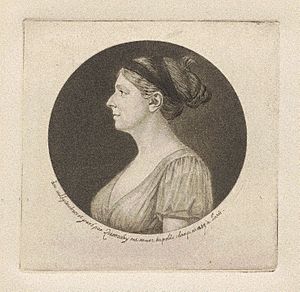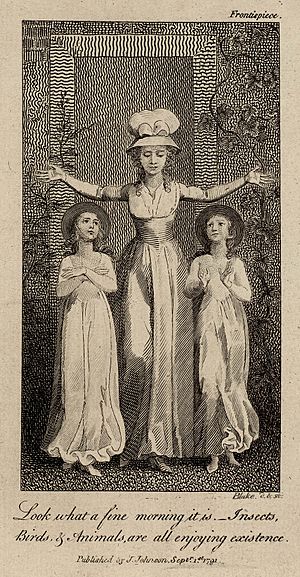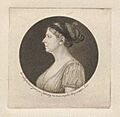Margaret King facts for kids
Quick facts for kids
Margaret King
|
|
|---|---|
 |
|
| Born | 1773 |
| Died | 1835 (aged 61–62) |
| Occupation | Intellectual hostess, writer |
Margaret King (1773–1835) was an important writer and hostess from Ireland. She was also known as Margaret King Moore, Lady Mount Cashell, and Mrs Mason. She wrote books to help women and give health advice.
Even though she came from a rich family, she believed in fairness for everyone. She had modern ideas about education and women's rights. This was partly because she was a favorite student of Mary Wollstonecraft, a famous early feminist writer. Later in life, Margaret moved to Italy. There, she helped Mary Wollstonecraft's daughter, Mary Shelley, who wrote Frankenstein. Margaret also helped Mary's husband, Percy Bysshe Shelley, and her stepsister, Claire Clairmont.
In Pisa, Italy, Margaret continued to study medicine. She had started these studies in Germany. She even dressed as a man to attend classes, as universities were only for men then. She wrote a popular book called Advice to Young Mothers. She also wrote a novel, The Sisters of Nansfield: A Tale for Young Women.
Contents
Early Life and Education
Margaret King was born in 1773 into the Kingsborough family. They were a powerful and wealthy family in Ireland. Her mother, Caroline Fitzgerald, was very rich. She married Margaret's father, Robert King, when she was only 15. The family lived at Mitchelstown Castle in County Cork. Margaret was one of nine children.
Learning from Mary Wollstonecraft
Margaret later wrote that her parents were too busy with parties to care for their children. So, before she was three, she had governesses and tutors. One of these was Mary Wollstonecraft, a pioneer in education and women's rights. Margaret was a very dedicated student of Wollstonecraft.

Wollstonecraft worked for the family for about a year. Margaret said that Wollstonecraft had "freed her mind from all superstitions." This means Wollstonecraft taught her to think for herself. She learned to question rules and ideas based only on someone's high social rank.
Some of Margaret's experiences with Wollstonecraft appeared in Wollstonecraft's children's book, Original Stories from Real Life (1788). The book features a kind governess named Mrs. Mason. Margaret King later used this name, Mrs. Mason, for herself.
Family Life and Marriage
Margaret became Lady Mount Cashell when she married Stephen Moore, 2nd Earl Mount Cashell. They married on September 12, 1791. She was 19, and he was 21.
Margaret and Stephen had seven children. Their oldest son, Stephen Moore, 3rd Earl Mount Cashell, went to Trinity College, Cambridge. He later started a farming community in Canada. Another son, Edward Moore, became a Canon at Windsor Cathedral.
Beliefs and Politics
Even after marriage and having children, Margaret kept her strong political beliefs. She attended important trials in London in 1794. She also joined a group of women in Dublin who wanted to improve their country. She was friends with Lord Edward FitzGerald, a leader of the Society of United Irishmen. This group wanted more rights for Irish people.
Some people in power, like the Bishop of Ossory, worried about women like Margaret. He said that revolutionary ideas were spreading among rich women. He believed these women had a big impact on society. Margaret's oldest brother, George King, supported the British government.
Margaret believed in the United Irishmen's cause. However, she still thought social differences were important. She wrote against the British government's plan to unite Ireland with Great Britain. She knew many important people who shared her views. These included Valentine Lawless, 2nd Baron Cloncurry, Charles James Fox, and Robert Emmet.
Travels and New Beginnings
In December 1801, Margaret and her husband went on a long trip called a grand tour. They traveled with a group of nine people, including a diarist named Catherine Wilmot. Wilmot wrote many letters home, describing their travels. They met important people like Napoleon and Thomas Paine in Paris.
In 1803, war started again in Europe. The group moved to Rome, hoping it would be safer. In Rome, Margaret met George William Tighe. He was an Irish gentleman who shared her interests and views. They became very close.
In 1805, Margaret's husband left her in Germany and returned to Ireland with their children. At that time, women had very few rights if they wanted to leave an unhappy marriage. Margaret and her husband officially separated in November 1812. She received money each year but never saw her children again.
Writing and Medical Studies
In 1813, Margaret wrote stories for a children's book called Stories of Old Daniel. This book was very popular. She had visited and become friends with William Godwin and his wife, Mary Jane Clairmont, in London. William Godwin was the widower of her former teacher, Mary Wollstonecraft.
After separating from her husband, Margaret was free to follow her own path with George Tighe. She studied medicine at the University of Jena in Germany. She attended lectures dressed as a man because women were not allowed to study medicine. She was tall and acted quiet to avoid being noticed. She continued her studies in Italy with a surgery professor. She even ran a clinic for the poor in Pisa.
In 1823, she published a very popular medical guide called Advice to Young Mothers on the Physical Education of Children, by a Grandmother. This book was printed many times in different countries. In her book, she said that female midwives were better than male doctors for childbirth. She also encouraged mothers to breastfeed their babies themselves. She believed this was better than using a wet nurse. She also advised parents to always be kind to their daughters.
After this book's success, she translated medical books from German. She also wrote a two-volume novel, The Sisters of Nansfield: A Tale for Young Women (1824). This story is about two young women who learn to question society's rules after their father dies.
Life in Italy
Margaret and George Tighe moved to Tuscany, Italy. They called themselves "Mr and Mrs Mason." This was the name of the kind governess in Mary Wollstonecraft's book. Margaret became known as a strong and wise woman. They lived in Pisa with their daughters, Lauretta and Nerina.
In 1820, Percy Shelley, his wife Mary Shelley, and Mary's stepsister Claire Clairmont visited them often. Margaret felt like a mother to Mary and Claire. She gave them good advice about their health and careers. She helped Mary set up her home in Pisa.
Margaret was a great influence on Percy Shelley. He even wrote a poem about her. Their friendship ended in 1822 when Percy Shelley drowned. Mary Shelley then returned to England.
Margaret's husband died in October 1822. She married George Tighe in March 1826. However, they separated a year later in 1827. That same year, she started hosting a regular meeting at her house in Pisa called the Accademia dei Lunatici (Society of Lunatics). Writers like Giacomo Leopardi and Giuseppe Giusti attended these meetings. They were important figures in the movement for Italian independence.
Claire Clairmont lived with Margaret in the 1830s. Claire saw Margaret as a mother figure and said that time was the happiest of her life. Claire stayed in touch with Margaret's daughters for many years.
Margaret, Lady Mount Cashell, passed away in January 1835. She was buried in the Old English Cemetery, Livorno. People described her as charming, smart, and kind. She was also known for her modern political ideas.
Works
- with Charles Lamb, William Godwin, Henry Corbould, and S. Springsguth, Stories of Old Daniel: Or, tales of wonder and delight (1813)
- Continuation of the Stories of Old Daniel (1820)
- Advice to Young Mothers on the Physical Education of Children, by a Grandmother (1823)
- The Sisters of Nansfield: A Tale for Young Women (two-volume novel) (1824)
Images for kids
See also
- Godwin-Shelley family tree


